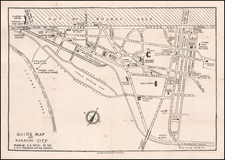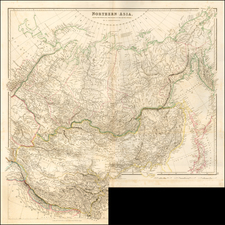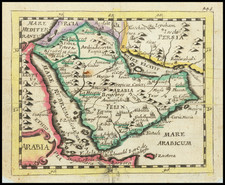Interesting map of the Mediterranean and contiguous regions by Pierre Du Val.
The title translates as Map of the Saracen Empire and the Caliphs under Walid who reigned around the year 700. Pulled from d'Abulfeda, Nassir-Eddin, Uleg-Bei and other Arab authors.
The map also includes a translation of place names from Arabic to French.
The Map is representative of the Mediterranean world during the Reign of Al-Walid, an Umayyad Caliph who ruled from 705 until his death in 715. His reign saw the greatest expansion of the Caliphate, as successful campaigns were undertaken in Transoxiana, Sind, Hispania and against the Byzantines. Under his reign, the Umayyad caliphate stretched from Northern Spain to Pakistan. They had even reached China under Walid, but failed to conquer because of a trick played by the Chinese emperor.
Walid continued his father's policies of expanding Islamic power through conquests and took the early Islamic empire to its farthest extent. In 711, Muslim armies crossed the Strait of Gibraltar and began to conquer the Iberian Peninsula. By 716, the Visigoths of Iberia had been defeated and Iberia was under Muslim control. In the east, Islamic armies made it as far as the Indus River in 712.
Walid also began the first major building projects of Islam. The history of Islamic architecture is said to have begun in earnest with Walid. Around 701, al-Walid ordered the building of Al-Aqsa Mosque, opposite his father's Dome of the Rock on the Temple Mount. Walid repaired and refurbished Masjid al Nabawi in Medina. He also improved roads, mountain passes and wells in Hijaz. It was during Walid's reign that Islamic court culture began to develop. With the Caliph as their patron, artists and writers began to develop a new, partly secular culture based on Islamic ideas.
Conversion was not forced on conquered peoples. However, non-believers had to pay an extra tax, so many people did convert for non-religious reasons. This created several problems, particularly since Islam was so closely connected with being Arab. Being Arab was more than an ethnic identity, it was a tribal identity based on kinship and descent. As more and more Muslims were non-Arabs, the status of Arabs and their culture was threatened. Because of this, Walid instituted Arabic as the only official language of the empire. He decreed that all administration was to be done only in Arabic. It was this move that cemented the primacy of Arabic language and culture in the Islamic world.
Pierre Duval (1618-1683) was a French geographer, cartographer, and publisher who worked in Abbeville and Paris during the seventeenth century. He was born in the former city, in northeast France, before moving to Paris. Duval was the nephew of the famous cartographer Nicolas Sanson, from whom he learned the mapmaker's art and skills. Both men worked at the royal court, having followed the royal request for artists to relocate to Paris. In addition to numerous maps and atlases, Du Val's opus also includes geography texts. He held the title of geographe ordinaire du roi from 1650 and died in 1683, when his wife and daughters took over his business.









![[Caspian Sea / Kamtchatka] Geographica Nova ex Oriente gratiosissima, duabus tabulis specialissimis contenta, quaram una Mare Caspium. . .](https://storage.googleapis.com/raremaps/img/small/89998.jpg)



![[The Travels of Paul] Tabula Geographica, in qua omnes regiones, urbes, oppida, et loca describuntur, quorum mentio fit in Actis et Epistolis Apostolotum, et Apocalypsi; de integro multis in locis emendata, ac regionum limitibus distincta, auct. Pet. Planc. . . .](https://storage.googleapis.com/raremaps/img/small/77970.jpg)
![[Portrait] L'Asie.](https://storage.googleapis.com/raremaps/img/small/79746.jpg)